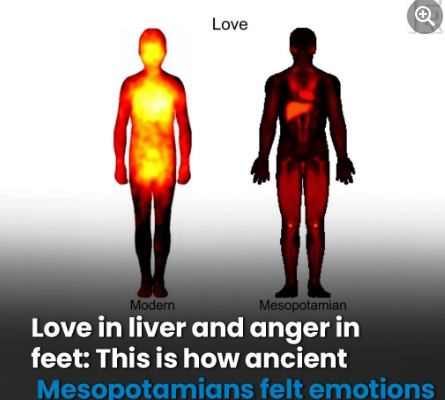Anger is experienced by modern humans in the upper body and hands, while Mesopotamians felt most ‘heated’, ‘enraged’ or ‘angry’ in their feet
Modern and Mesopotamian people experience love in a rather similar way. In Mesopotamia, love is particularly associated with the liver, heart and knees
Modern/PNAS: Lauri Nummenmaa
Arecent analysis of one million words of the ancient Akkadian language revealed that people in ancient Mesopotamia felt love in their livers and anger in their feet.
The details were revealed by a multidisciplinary team of researchers after studying the large body of texts, which is from 934-612 BC in the form of cuneiform scripts on clay tablets.
Researchers mentioned that people dozens of centuries ago experienced emotions in their bodies.
Understanding of anatomy in ancient Mesopotamia
“Even in ancient Mesopotamia, there was a rough understanding of anatomy, for example the importance of the heart, liver and lungs,” said Professor Saana Svärd of the University of Helsinki, an assyriologist who is leading the research project. One of the most intriguing findings relates to where the ancients felt happiness, which was often expressed through words related to feeling ‘open,’ ‘shining,’ or being ‘full’ – in the liver.
Researchers also claimed that since literacy was rare in Mesopotamia (3000-300 BCE), cuneiform writing was mainly produced by scribes and, therefore, available only to the wealthy. However, cuneiform clay tablets contained a wide variety of texts, such as tax lists, sales documents, prayers, literature, and early historical and mathematical texts.
Cognitive neuroscientist Juha Lahnakoski, a visiting researcher at Aalto University, stated that if you compare the ancient Mesopotamian bodily map of happiness with modern bodily maps, it is largely similar, with the exception of a notable glow in the liver.
Mesopotamians felt most ‘heated,’ ‘enraged,’ or ‘angry’ in their feet
Other contrasting results between ourselves and the ancients can be seen in emotions such as anger and love. According to previous research, anger is experienced by modern humans in the upper body and hands, while Mesopotamians felt most ‘heated,’ ‘enraged,’ or ‘angry’ in their feet.
Meanwhile, love is experienced quite similarly by modern and Neo-Assyrian man, although in Mesopotamia, it is particularly associated with the liver, heart, and knees, according to a press release.
Svärd highlighted that it remains to be seen whether “we can say something in the future about what kind of emotional experiences are typical for humans in general and whether, for example, fear has always been felt in the same parts of the body. Also, we have to keep in mind that texts are texts and emotions are lived and experienced.”
Researchers also underlined that modern and Mesopotamian people experience love in a rather similar way. In Mesopotamia, love is particularly associated with the liver, heart, and knees.
While modern humans often report feeling anger in their upper body and hands, Mesopotamians described anger as concentrated in their feet, using terms like “heated” and “enraged.” Love was another emotion with intriguing differences.



